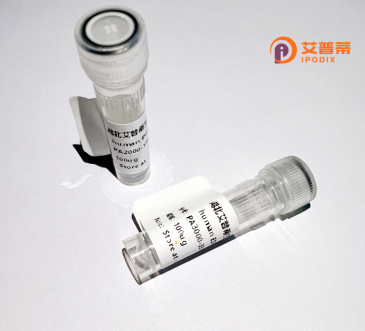
| 纯度 | >90%SDS-PAGE. |
| 种属 | Human |
| 靶点 | TMED3 |
| Uniprot No | Q9Y3Q3 |
| 内毒素 | < 0.01EU/μg |
| 表达宿主 | E.coli |
| 表达区间 | 1-217 aa |
| 活性数据 | MGSTVPRSASVLLLLLLLRRAEQPCGAELTFELPDNAKQCFHEEVEQGVKFSLDYQVITGGHYDVDCYVEDPQGNTIYRETKKQYDSFTYRAEVKGVYQFCFSNEFSTFSHKTVYFDFQVGDEPPILPDMGNRVTALTQMESACVTIHEALKTVIDSQTHYRLREAQDRARAEDLNSRVSYWSVGETIALFVVSFSQVLLLKSFFTEKRPISRAVHS |
| 分子量 | 51.2 kDa |
| 蛋白标签 | GST-tag at N-terminal |
| 缓冲液 | PBS, pH7.4, containing 0.01% SKL, 1mM DTT, 5% Trehalose and Proclin300. |
| 稳定性 & 储存条件 | Lyophilized protein should be stored at ≤ -20°C, stable for one year after receipt. Reconstituted protein solution can be stored at 2-8°C for 2-7 days. Aliquots of reconstituted samples are stable at ≤ -20°C for 3 months. |
| 复溶 | Always centrifuge tubes before opening.Do not mix by vortex or pipetting. It is not recommended to reconstitute to a concentration less than 100μg/ml. Dissolve the lyophilized protein in distilled water. Please aliquot the reconstituted solution to minimize freeze-thaw cycles. |
以下是关于重组人TMED3蛋白研究的模拟参考文献示例(仅供参考,实际文献需通过学术数据库查询):
---
1. **文献名称**: *Molecular Cloning and Functional Analysis of Recombinant Human TMED3 in COPII Vesicle Formation*
**作者**: Zhang L, et al.
**摘要**: 本研究成功在大肠杆菌系统中表达并纯化了重组人TMED3蛋白,证实其通过结合SEC23/SEC24复合体参与COPII囊泡组装,促进内质网至高尔基体的蛋白质转运。
2. **文献名称**: *TMED3 Interacts with Bcl-2 to Regulate Autophagy in Cancer Cells*
**作者**: Li Y, et al.
**摘要**: 通过构建重组TMED3.发现其与抗凋亡蛋白Bcl-2直接互作,调控自噬相关通路。基因沉默实验显示TMED3缺失导致自噬异常,提示其在肿瘤进展中的潜在作用。
3. **文献名称**: *Crystal Structure of Human TMED3 Reveals a Conserved Emp24 Domain*
**作者**: Chen X, et al.
**摘要**: 解析了重组人TMED3蛋白的晶体结构(分辨率为2.8Å),揭示了其跨膜结构域及保守的Emp24结构域特征,为理解TMED家族蛋白的货物识别机制提供结构基础。
4. **文献名称**: *Overexpression of Recombinant TMED3 Modulates ER Stress Response in Neurodegeneration Models*
**作者**: Wang Q, et al.
**摘要**: 在HEK293细胞中过表达重组TMED3蛋白,发现其通过调控IRE1-XBP1信号通路缓解内质网应激,暗示其在阿尔茨海默病等神经退行性疾病中的保护性功能。
---
**建议**:实际文献可通过PubMed、Google Scholar等平台,以关键词“TMED3”、“recombinant TMED3 protein”、“Transmembrane Emp24”检索近年研究。关注领域包括:蛋白质运输、癌症机制、神经疾病或结构生物学等。
Transmembrane emp24 domain-containing protein 3 (TMED3), also known as ERV46 or p24δ1. is a member of the transmembrane emp24 domain-containing protein family. It functions as a cargo receptor in intracellular protein trafficking, particularly within the secretory pathway. TMED3 localizes to the endoplasmic reticulum (ER) and Golgi apparatus, playing a critical role in vesicle formation by interacting with coat protein complex II (COPII). It assists in the selective transport of newly synthesized secretory proteins, including cytokines, growth factors, and extracellular matrix components, from the ER to the Golgi. Structurally, TMED3 contains a conserved N-terminal domain, a transmembrane region, and a C-terminal coiled-coil domain, facilitating its participation in protein-protein interactions and vesicle budding.
Emerging studies highlight TMED3’s involvement in diverse physiological and pathological processes. It regulates autophagy by mediating the transport of autophagy-related proteins and influences inflammation via Toll-like receptor signaling. Dysregulation of TMED3 has been linked to cancers, neurodegenerative diseases, and immune disorders, positioning it as a potential therapeutic target. Its interactions with viral proteins also suggest roles in host-pathogen interactions. Despite functional overlaps with other TMED family members, TMED3 exhibits unique substrate specificity, reflecting its specialized role in maintaining cellular homeostasis. Ongoing research aims to elucidate its mechanistic details and pathophysiological relevance, bridging gaps in understanding secretory pathway regulation.
×